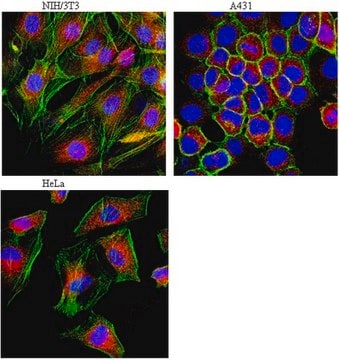L0419
Anti-LAMP1−Cy3™ antibody produced in rabbit
1-2 mg/mL, affinity isolated antibody, buffered aqueous solution
Sinónimos:
Anti-CD107a, Anti-LAMPA, Anti-LGP120, Anti-Lysosomal-associated membrane protein 1
About This Item
Productos recomendados
origen biológico
rabbit
conjugado
CY3 conjugate
forma del anticuerpo
affinity isolated antibody
tipo de anticuerpo
primary antibodies
clon
polyclonal
formulario
buffered aqueous solution
reactividad de especies
mouse, human, rat
concentración
1-2 mg/mL
técnicas
direct immunofluorescence: 1-2 μg/mL using human HeLa cells, rat NRK cells and mouse 3T3 cells
Nº de acceso UniProt
Condiciones de envío
wet ice
temp. de almacenamiento
2-8°C
modificación del objetivo postraduccional
unmodified
Información sobre el gen
human ... LAMP1(3916)
mouse ... Lamp1(16783)
rat ... Lamp1(25328)
Descripción general
Aplicación
Acciones bioquímicas o fisiológicas
Forma física
Información legal
Cláusula de descargo de responsabilidad
Not finding the right product?
Try our Herramienta de selección de productos.
Producto relacionado
Código de clase de almacenamiento
12 - Non Combustible Liquids
Clase de riesgo para el agua (WGK)
WGK 2
Punto de inflamabilidad (°F)
Not applicable
Punto de inflamabilidad (°C)
Not applicable
Equipo de protección personal
Eyeshields, Gloves, multi-purpose combination respirator cartridge (US)
Certificados de análisis (COA)
Busque Certificados de análisis (COA) introduciendo el número de lote del producto. Los números de lote se encuentran en la etiqueta del producto después de las palabras «Lot» o «Batch»
¿Ya tiene este producto?
Encuentre la documentación para los productos que ha comprado recientemente en la Biblioteca de documentos.
Nuestro equipo de científicos tiene experiencia en todas las áreas de investigación: Ciencias de la vida, Ciencia de los materiales, Síntesis química, Cromatografía, Analítica y muchas otras.
Póngase en contacto con el Servicio técnico






